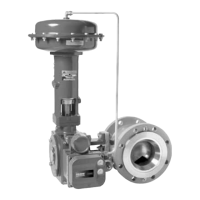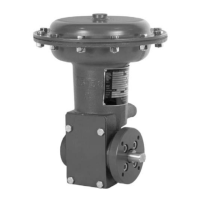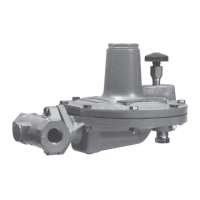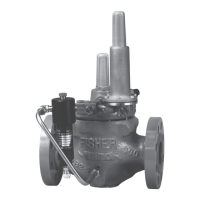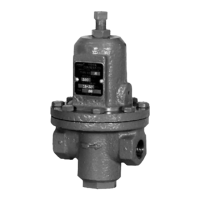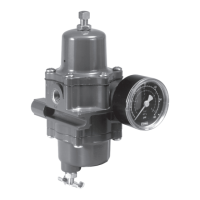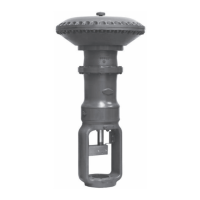Types 1098-EGR and 1098H-EGR
4
Principle of Operation
The pilot-operated Types 1098-EGR and 1098H-EGR
regulators both use inlet pressure as the operating
medium, which is reduced through pilot operation to
load the actuator diaphragm. Outlet or downstream
pressure opposes loading pressure in the actuator
and also opposes the pilot control spring. The
Type 1098- EGR regulator operation schematic is
shown in Figure 2.
In operation, assume that outlet pressure is below
the pilot control setting. Control spring force on the
pilot diaphragm opens the pilot valve plug providing
additional loading pressure to the actuator diaphragm.
This loading pressure forces the actuator stem
forward, opening the main valve plug via a bump
connection. The upward motion of the plug allows gas
to ow through the cage into the downstream system.
When downstream demand has been satised, outlet
pressure tends to increase, acting on the pilot and
actuator diaphragms. This pressure exceeds the pilot
control spring setting, moving the pilot diaphragm
away and letting the valve plug spring (Type 6351,
61 Series or Type Y600AM pilots) or bellows
(Types 6352 through 6354M pilots) close the pilot
valve plug (unbalanced in the Type 6351 or 61 Series
pilots but balanced in the Types 6352 through 6354M
pilots). Excess loading pressure on the actuator
diaphragm escapes downstream through the bleed
hole (Type 6351 pilot), bleed orice (61 Series pilot),
restriction (Types 6352 through 6354M pilots) or xed
restrictor (Type Y600AM pilot).
Reduced actuator loading pressure permits the main
valve to close. The combination of main valve spring
force and valve plug imbalance provides positive valve
plug shutoff against the port and upper seals.
To protect the Type 1098 or 1098H actuator diaphragm
from excessive differential pressure, the 6350 Series
pilots have an integral check valve that allows loading
pressure to bleed downstream at approximately
25 psig / 1.7 bar differential across the actuator
diaphragm. An external check valve (Type 1806)
is required when differential is higher than 25 psi /
1.7 bar or when using the 61 Series or Y600AM pilots.
with the normal operation of the regulator.
Table 5. Recommended Type MR95H Pressure Settings for Use with the Type Y600AM Pilot
BODY SIZE
TYPE EGR
SPRING COLOR
SUPPLY PRESSURE
Type Y600AM Spring Color
Red Unpainted Yellow Green Light Blue Black
NPS DN psig bar psig bar psig bar psig bar psig bar psig bar
1 25
Green
Blue
Red
6
7
8
0.41
0.48
0.55
6
7
8
0.41
0.48
0.55
7
8
9
0.48
0.55
0.62
8
10
11
0.55
0.69
0.76
11
13
14
0.76
0.90
0.97
13
14
15
0.90
0.97
1.0
2 50
Green
Blue
Red
6
8
13
0.41
0.55
0.90
6
8
13
0.41
0.55
0.90
7
9
14
0.48
0.62
0.97
9
11
16
0.62
0.76
1.1
12
14
19
0.83
0.97
1.3
13
15
20
0.90
1.0
1.4
3 80
Green
Blue
Red
7
9
14
0.48
0.62
0.97
7
9
14
0.48
0.62
0.97
8
10
15
0.55
0.69
1.0
10
12
17
0.69
0.83
1.2
13
15
20
0.90
1.0
1.4
14
16
21
0.97
1.1
1.5
4 100
Green
Blue
Red
8
11
16
0.55
0.76
1.1
8
11
16
0.55
0.76
1.1
9
12
17
0.62
0.83
1.2
11
14
19
0.76
0.97
1.3
14
17
22
0.97
1.2
1.5
15
18
23
1.0
1.2
1.6
6 or 8 x 6
150 or
200 x 150
Green
Blue
Red
13
17
22
0.90
1.2
1.5
13
17
22
0.90
1.2
1.5
14
18
23
0.97
1.2
1.6
15
20
25
1.0
1.4
1.7
18
23
28
1.2
1.6
1.9
20
24
29
1.4
1.7
2.0
1. The pressures shown in the table are the minimum supply pressures required by the pilot. If the inlet pressure is less than shown, an external pilot supply is necessary.

